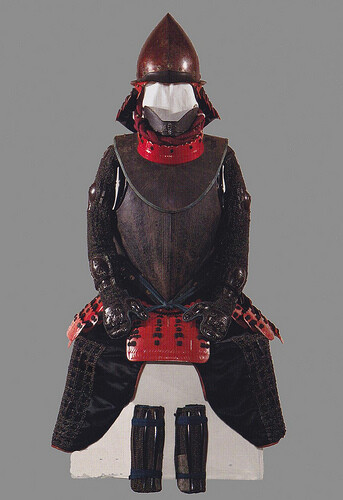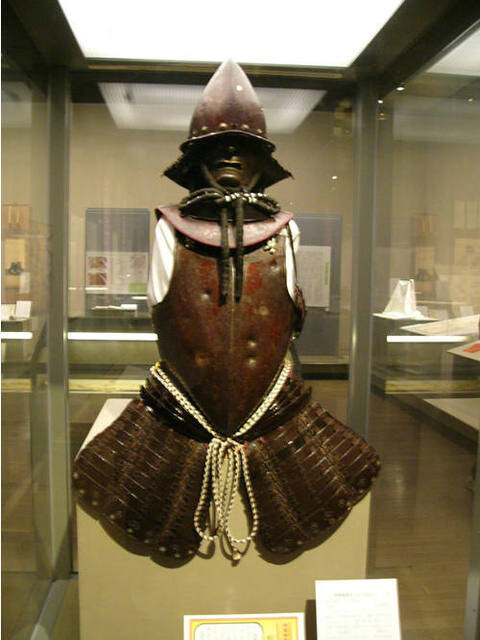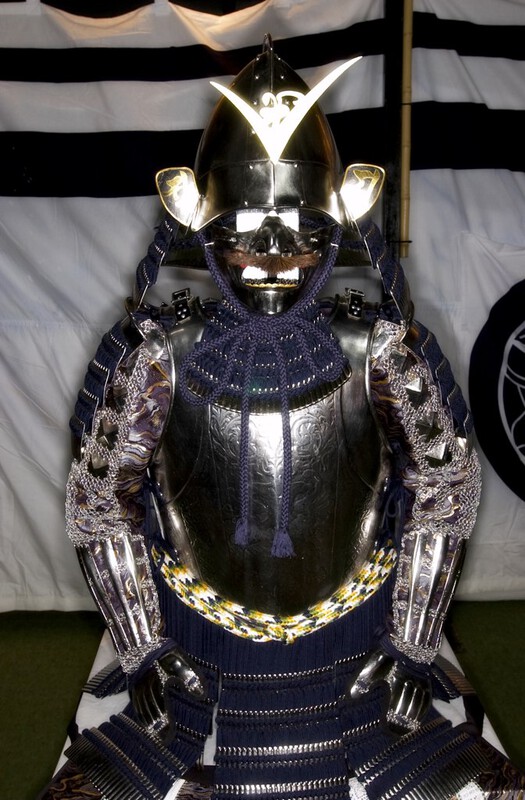-
Posts
732 -
Joined
-
Last visited
-
Days Won
1
Content Type
Profiles
Forums
Events
Store
Downloads
Gallery
Everything posted by kaigunair
-
Guess it's an unusual one?
-
Been carrying this one in the pocket a while. Seems very old to me. Shoami would be the easy call, but I am hoping some member have seen others like it? Brass dots and rims around everything made me think onin/heianjo/kamakura but sukashi is probably too big for such a call. Proto/ko something? 53x58mm (Using mobile to do this and not sure I have the resizing down; gomenasai)
-
Wow, I like it! Looks like the plug was made as part of the Tsuba indeed. Very interesting. Would make sense as a client might be unsure whether it will be mounted with or without a kogai. Could you take closer pics? Workmanship looks pretty nice but would love to see closer pics of the clouds and waves. Ps: the two holes at the bottom are usually attributed to satsuma mounts.
-
Large indeed, but there are even bigger/heavier examples out there. depends on who you ask. there are also two different questions/statements here, 1) was it made by a "tsuba maker"? and 2) is it a "tsuba"?. Seems like it is possibly of Japanese origin, but the Chinese stuff has been getting pretty lively and interesting. Would be late late late period if Japanese, I'm thinking possibly modern actually. If genuine, it would fall into the curio/art piece (I have such an example) which some purists don't consider a "real tsuba". Similar arguments made for late soft metal works in general. Doesn't mean the nice examples are commanding high prices at auction (due to broader appeal IMO). I guess I'm just not sure if this one is completely kosher. Does seem nicer than the ebay fakes, but something seems alittle...off....
-
Thanks Uwe. Lovely collection! But, anyone know if Kenshin had a Gusoku with a European cuirass, or if the one picture is just a fantasy piece? Any known books on Armor of the Uesugi clan?
-
-
I'm familiar with the Tokugawa gusoku that incorporated European armor, but I came across this picture of a reproduction of sorts. I was wondering if this was modeled after some armor of Kenshin's that did in fact also use European cuirass or breastplate? If so, does any one have pictures of the original?
-
Definitely a neat "twist" on the theme! Seems like they did get pretty creative in the end. Thanks for sharing it!
-
Unfortunate turn on this thread. Happens from time to time, but never nice to see. Especially between two members whose opinion I don't always agree with, but always know its going to be treat to hear; I can always count on their posts as being of original thought, unlike much of the bandwagoning onto other's thoughts and opinions that occurs way too much....perhaps trying to log higher post counts, in the way some manage facebook friend numbers... But I know I too am guilty of thinking that some people shouldn't post what they don't know about...but then realize later that perhaps their post did provide some insightful comment (even if unintentionally ) when I took the time to take it seriously and dive into preparing a full and proper response, even if it never gets posted... Wish the 'net had a better way to virtually hold these types of conversations that are better done at a table with a round of .... PS: Per the post's original questions, I would have guessed late edo, possibly for export. Most importantly, not of high quality. Could be a combo of casting plus some finishing work on the surface and back. Speeds up production while adding some level of detail. My caveats: I 'm really bad at seeing the quality of work in very early kinko fittings (ezo, mino, kyo...), and I'm in the amateur hobbyist/armchair historian category...
-
-
Kanji's match. The differences you noticed are also kantei points which can help to verify whether the signature is legit or gimie. For that, you need examples or pictures of known works to compare to... Welcome to the world of tosogu!
-
Seems to me it would make a great compliment to a tanto in yorori doshi, eh?
-
Thanks ford. :D
-
Ah, much more informative. However, in light of the above comments, what would happen if the mei were gone? What about this piece would distinguish it as a sakura yamakichibei then? While the execution would be nice and tight, what about the design is inspired? ...that a true connoisseur would latch onto and say, "Wow, now that's a different and exciting way of executing this particular design. This must have been made by really skilled tsubako with a true artist's eye". As you yourself have pointed out in other posts, unsigned machibori works are sometimes very hard to attribute to a school, since the work could have been done by any number of skilled artisans. The works themselves are executed well, but there isn't anything unique about them. I posit that the exact comment could be made about this tsuba design if the signature was removed. Nice execution, uninspired. No characteristics that are directly attributable to the yamakichibei line, either in the texture of the iron or the execution of the design. Yet, it is that signature and attribution which will drive up the value of this example, yes? So, I'm still left wondering, what makes this a yamakichibei design? If not the signature, then what would a "true" connoisseur be paying $$$ for? I'm thinking it would be much less than what this piece will end up fetching because of the signature. Now if the point I'm missing is that this design itself is inspired and shows traits and workmanship characteristic of the yamakichibei 3rd gen or yamakichibei school in general, I would pay to know that info! (For contrast, I find that I can often spot Natsuo pieces in auction catalogues from a mile away. he has that particular way of executing rain and water, not to mention placement of designs and use of space that is really lovely. too bad they are way outta my price range. at the same time, his pieces commissioned to replace or repair older fittings, while nice, don't hold much appeal for me. but if I ran into one of his original work (and I had the funds), I would gladly pay for one without a signature based only on the strength of his design.)
-
hmmm...this blade is being listed in my neck of the woods via an online classifieds ad site....
-
:lol: I'm still not appreciating either the design nor find much interest in the iron texture of this particular piece, but then again, my reference points for design are late edo machibori. I'd really like to see more early ko-akasaka works up close and personal, which I'm hoping will be sooner than later . Is it possible the later akasaka generation works are put down more for the lack of interesting execution of designs than for their iron, though it does seem the comments on lower akasaka iron quality is echoed in more than one of the old stand-by english tsuba books. At the same time, I can see why certain "tsuba activity", such as large tekkotsu or globby yakite, might be valued in the same way that the activity in nihonto hada and hamon is valued against those with less or without. Just like a very tight ji and suguha, while a mark of good craftsmanship and not necessarily a gunto steel blade, might not command the same interest and $$$ as an equally well executed mokume and choji.... Any who, this "3rd gen" yamakichibei work is definitely different from the more typical "lumpy" yamakichibei works that make that school famous, and which I am learning to appreciate. Would love to hear WHY this particular piece is better executed than other examples of the same theme, what kantei points are present that place this above others. Now a post like that would be very helpful and interesting indeed. ps: Makes me think I should post up a tsuba I been carrying around in my pocket for a few weeks....something along the lines of proto-akasaka (vs ko-akasaka), an idea which is really expanded upon in Haynes' most recent book...
-
Probably time for the admins to change the title to the "MAK-daddy" thread... I would have thought that pics in 1923 would have been done by professional given the higher costs, but makes sense that each is professional off in the same way.
-
Interesting! I would wonder whether the "thickness" of the opening could indicate if one or another was used? I'm thinking that a kogatana would be much thinner than the shaft of a kogai. So a slot for a kogai might not hold a kozuka/kogatana securely and a kozuka slot might not be wide enough to allow a kogai into? Now if the slot was made so there was a middle channel or bulge down the length to accommodate the kogai, it could possibly hold both? Caveat: I don't have many katana sized sayas with both the cut outs to compare the kogai vs kozuka slots. Also, the only kogai example I have in my collection is Edo period, and it appears to be a larger & thicker example. If earlier kogai shafts were thinner in construction, or kogatana were thicker per-Edo, this totally throws out my ideas....
-
Thanks for the photo. Very interesting. Other than the "signature", the iron doesn't seem that interesting to me... Looking forward to hearing what the experts have to say.
-
It does appear to be a lot of effort for many low quality items, but I do see there are some decent kinko examples, just not much high end stuff (maybe 1506?). What I can't believe is the extent of the bad angle of the lighting and the huge shadow its casting. All that work photo'ing for such poor results. That, and the fact that it is b&w makes the machibori kinko work harder to appreciate. I also see some nice early brass tsuba (1531?). But no tetsu jumped out at me (although that is where I am most lacking). A commendable effort overall , but just fixing the lighting would have at least made this a much more useful reference catalog....
-
fyi, I was just reading the kigen sasano book where he identifies kogai whose designs indicate they were mounted in the kozuka side (i.e., design looks upside down if mounted on the side away from the body). It does not indicate whether the size of the kogai was indicative of wak or katana or tachi though.
-
wow, neat find. has a good chance of being a real kamakura bori example...the nakago ana being added later is still ok for something this old. and having the added nakago ana makes it seem even more legit!
-
Hi Roman, Thanks for the second/third look and comments. Will give them some thought.









